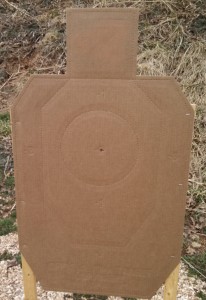By now, you’ve probably seen something about the 2nd Amendment activist in Florida who got shot by her own 4-year-old son while she was driving. The news stories say she was in the driver’s seat of a pickup truck pulling a trailer when her son, who was sitting in the back seat of the four-door truck, got access to her .45 caliber 1911 handgun. He fired one shot, which went through the back of her seat and hit her in the back.
How does this make you feel? Does it make you angry? Maybe a little smug, because we know better and would never do anything like this? Sad? Worried about the legal and political backlash for other gun owners?
She’s of course getting torn to pieces by commenters on her own page — or was, the last time I looked. Might be down by now. It’s easy to rant and condemn and of course the violently-minded antigun people are having a field day. But …
The only thing worse than a tragedy is a tragedy nobody learns from. So we should keep our focus on learning, not condemning.
What can we learn here?
It’s so easy to think of a situation like this as a sin so we can burn the heretic at the stake and feel smug about our own righteousness. But maybe it’s better to use this as an eye opener for our own habits — mine included.
As I type this, there’s a loaded gun sitting in a holster on my desk, near my right elbow. It’s there because I was lazy and pulled it off my belt earlier this morning. It’s fine, no problems, because I’m the only one in the house right now. But it’s also maybe a safety concern that I should stop doing, because you know and I know that at some point I’m going to get up from the computer and walk into the other room (to get a drink, to use the toilet, whatever) and I might forget to take the gun with me. I’ve done that before. And if it’s not with me, there’s just the off chance that I’ll forget that it’s there entirely when someone stops by the house — and that would not be okay. So this habit I’ve developed, maybe I should look at it more closely and change something.
Where have potentially-unsafe habits crept into your life? Anything you could or should improve? Think about it…
Kids
Three of our sons came across a (loaded? unloaded?) gun in a range bag on the back seat of a car one day, years ago. We were fortunate, because they did not touch it. They told us about it instead (YAY! for kids who do the right thing). But it’s often left me with cold chills, thinking about What Might Have Been.
It’s one of the reasons I’m such a fan of on-body carry. Guns in purses, packs, and bags are more likely to end up in the hands of children than guns in holsters are. That’s not a condemnation; it’s just a fact.
It’s also one of the reasons I’m a fan of teaching kids what to do when they see a gun, and disarming their curiosity by letting them handle guns under carefully controlled adult supervision. As we see here, though, that’s not a guarantee. Kids make mistakes sometimes. Even kids who know the right thing to do don’t always do it. (This is news?)
Still, for anyone who hasn’t gotten the memo, here’s what every parent should teach their children to do when they see a gun:
- Stop.
- Don’t touch!
- Leave the area.
- Tell an adult.
There’s more to kids and gun safety than that, though. For instance, Dr. LateBloomer of the BoosterShots blog writes this:
… parents tend to under-estimate their child’s physical abilities when it comes to hazards. They think that Johnny is a genius, but that he can’t open the pool gate. They think that Susie will grow up to be a Rhodes Scholar, but that she can’t find a way to reach the top of the refrigerator where grandpa keeps his “bang-bang”. They think that Bobby can’t work the zipper on grandma’s purse to get to her heart medication “candy”, and they think that Janie isn’t strong enough to pull the trigger on mommy’s purse gun. The ER, and the Pediatric Intensive Care Unit, and the county coroner all will tell you how tragically wrong those assumptions are.
Go read the whole thing, and think about it.
“But I carry a …”
Had an interaction with some people online who felt this type of thing could never happen to them or to their families, because they used guns that
- had an external safety.
- had no round in the chamber, just in the magazine.
- had a long, heavy trigger pull.
Any of these ideas might sound comforting, but really? Think it through: the first and most important rule of gun safety is that we always treat every gun with the same cautious respect we’d give it if we knew for sure the gun was loaded and would fire if we press the trigger. Having the mindset that we’re willing to treat a gun with less concern simply because it’s “on safe” — or because it’s not really loaded, or because it has a stiff trigger — is a step backward in the safety department.
Complacency is the big danger here. We should be just as worried about our kids having access to ‘unloaded’ or ‘nothing in the chamber’ guns as we are about them accessing loaded ones. If we’re not, the danger isn’t the status of the gun. The danger is our own lack of concern about kids getting to it. Complacency kills.
If you can’t trust yourself to keep the gun where your kids can’t get it, you should not expect the gun to somehow keep itself from being fired. It won’t. It is that simple. Parents who are comforted by half-measures like these tend to be less dedicated to keeping the gun away from their children. That’s a bad thing.
“But the kids can’t …”
Kids can almost always do more, sooner, than their parents give them credit for. Some time back, my friend Melody Lauer set out to (safely) prove this with her own children. She found that even her toddlers could easily — I’m talking a matter of seconds here! — get the safety off and press a trigger, without any instructions or intervention from her. She wrote up her results, which she graciously shared with me, and I’m told the article will be published “soon”. For now, please take this as gospel: believing that your kids can’t actually pull the trigger, or take the safety off, or run the slide, is a false comfort. Chances are, they can.
So look around your house. Is there anything you can do to improve your own safety behavior? Anything you can change for the better in the everyday habits you use to keep your children safe?
Is every gun in your home either on your body, or locked up securely enough to keep adults out?
Don’t trust “child-proof” anything. Don’t believe that your kids don’t have the dexterity or strength to manipulate your firearm if they get to it. Don’t leave guns or gun gear lying around for the kids to poke through. Don’t believe that it’s good enough to simply educate your kids.
Stay safe. Keep your kids safe. Think about what you can do to help them stay safer.











